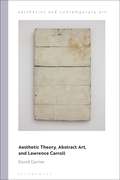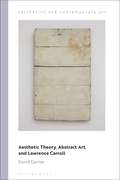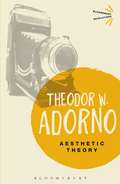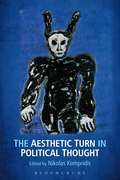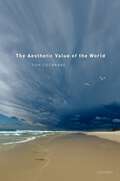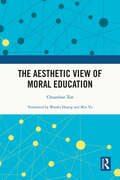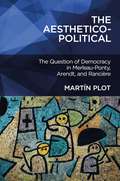- Table View
- List View
Aesthetic Theory, Abstract Art, and Lawrence Carroll (Aesthetics and Contemporary Art)
by David CarrierBoldly developing the central traditions of American modernist abstraction, Lawrence Carroll's paintings engage with a fundamental issue of aesthetic theory, the nature of the medium of painting, in highly original, frequently extraordinarily successful ways. Aesthetic Theory, Abstract Art, and Lawrence Carroll explains how he understands the medium of painting; shows what his art says about the identity of painting as an art; discusses the place of his paintings in the development of abstraction; and, finally, offers an interpretation of his art. The first monograph devoted to him, this philosophical commentary employs the resources of analytic aesthetics. Art historians trace the development of art, explaining how what came earlier yields to what comes later. Taking for granted that the artifacts they describe are artworks, art historians place them within the history of art. Philosophical art writers define art, explain why it has a history and identify its meaning. Pursuing that goal, Aesthetic Theory, Abstract Art, and Lawrence Carroll roams freely across art history, focused at some points on the story of old master painting and sometimes on the history of modernism, but looking also to contemporary art, in order to provide the fullest possible philosophical perspective on Carroll's work.
Aesthetic Theory, Abstract Art, and Lawrence Carroll (Aesthetics and Contemporary Art)
by David CarrierBoldly developing the central traditions of American modernist abstraction, Lawrence Carroll's paintings engage with a fundamental issue of aesthetic theory, the nature of the medium of painting, in highly original, frequently extraordinarily successful ways. Aesthetic Theory, Abstract Art, and Lawrence Carroll explains how he understands the medium of painting; shows what his art says about the identity of painting as an art; discusses the place of his paintings in the development of abstraction; and, finally, offers an interpretation of his art. The first monograph devoted to him, this philosophical commentary employs the resources of analytic aesthetics. Art historians trace the development of art, explaining how what came earlier yields to what comes later. Taking for granted that the artifacts they describe are artworks, art historians place them within the history of art. Philosophical art writers define art, explain why it has a history and identify its meaning. Pursuing that goal, Aesthetic Theory, Abstract Art, and Lawrence Carroll roams freely across art history, focused at some points on the story of old master painting and sometimes on the history of modernism, but looking also to contemporary art, in order to provide the fullest possible philosophical perspective on Carroll's work.
Aesthetic Theory (PDF)
by Theodor W AdornoTheodor Adorno (1903-69) was undoubtedly the foremost thinker of the Frankfurt School, the influential group of German thinkers that fled to the US in the 1930s, including such thinkers as Herbert Marcuse and Max Horkheimer. His work has proved enormously influential in sociology, philosophy and cultural theory. Aesthetic Theory is Adorno's posthumous magnum opus and the culmination of a lifetime's investigation. Analysing the sublime, the ugly and the beautiful, Adorno shows how such concepts frame and distil human experience and that it is human experience that ultimately underlies aesthetics. In Adorno's formulation 'art is the sedimented history of human misery'.
The Aesthetic Thought and View of Art of Thomas Aquinas
by Zhiqing ZhangThis book examines Aquinas's aesthetic thought and view of art within the broader context of medieval aesthetics and the history of aesthetic development, emphasizing its profound influence on later aesthetics. The book not only elaborates on Aquinas's efforts to establish coherence between faith and reason, the transcendent and empirical, as well as its significance, but also discusses the main contents and characteristics of Aquinas's aesthetic thought from the three aspects of the ontology of beauty, the theory of form, and the theory of experience. By examining Aquinas's aesthetic thought and view of art in relation to modern aesthetics and twentieth-century aesthetics, this book reveals the immense vitality of Aquinas's aesthetic thought.
The Aesthetic Turn in Political Thought
by Nikolas KompridisThe growing exploration of political life from an aesthetic perspective has become so prominent that we must now speak of an "aesthetic turn†? in political thought. But what does it mean and what makes it an aesthetic turn? Why now? This diverse and path-breaking collection of essays answers these questions, provoking new ways to think about the possibilities and debilities of democratic politics.Beginning from the premise that politics is already "aesthetic in principle,†? the contributions to The Aesthetic Turn in Political Thought from some of the world's leading political theorists and philosophers, disclose a distinct set of political problems: the aesthetic problems of modern politics. The aesthetic turn in political thought not only recognizes that these problems are different in kind from the standard problems of politics, it also recognizes that they call for a different kind of theorizing – a theorizing that is itself aesthetic.A major contribution to contemporary theoretical debates, The Aesthetic Turn in Political Thought will be essential reading to anyone interested in the interdisciplinary crossroads of aesthetic and politics.
The Aesthetic Turn in Political Thought
by Nikolas KompridisThe growing exploration of political life from an aesthetic perspective has become so prominent that we must now speak of an “aesthetic turn” in political thought. But what does it mean and what makes it an aesthetic turn? Why now? This diverse and path-breaking collection of essays answers these questions, provoking new ways to think about the possibilities and debilities of democratic politics.Beginning from the premise that politics is already “aesthetic in principle,” the contributions to The Aesthetic Turn in Political Thought from some of the world's leading political theorists and philosophers, disclose a distinct set of political problems: the aesthetic problems of modern politics. The aesthetic turn in political thought not only recognizes that these problems are different in kind from the standard problems of politics, it also recognizes that they call for a different kind of theorizing – a theorizing that is itself aesthetic.A major contribution to contemporary theoretical debates, The Aesthetic Turn in Political Thought will be essential reading to anyone interested in the interdisciplinary crossroads of aesthetic and politics.
The Aesthetic Value of the World
by Tom CochraneIn The Aesthetic Value of the World, Tom Cochrane defends Aestheticism, the claim that everything is aesthetically valuable and that a life lived in pursuit of aesthetic value can be a particularly good one. Furthermore, in distilling aesthetic qualities, artists have a special role to play in teaching us to recognize values; a critical component of virtue. Cochrane grounds his account upon an analysis of aesthetic value as 'objectified final value', which is underwritten by an original psychological claim that all aesthetic values are distal versions of practical values. This is followed by systematic accounts of beauty, sublimity, comedy, drama, and tragedy, as well as appendix entries on the cute, the cool, the kitsch, the uncanny, the horrific, the erotic, and the furious.
The Aesthetic Value of the World
by Tom CochraneIn The Aesthetic Value of the World, Tom Cochrane defends Aestheticism, the claim that everything is aesthetically valuable and that a life lived in pursuit of aesthetic value can be a particularly good one. Furthermore, in distilling aesthetic qualities, artists have a special role to play in teaching us to recognize values; a critical component of virtue. Cochrane grounds his account upon an analysis of aesthetic value as 'objectified final value', which is underwritten by an original psychological claim that all aesthetic values are distal versions of practical values. This is followed by systematic accounts of beauty, sublimity, comedy, drama, and tragedy, as well as appendix entries on the cute, the cool, the kitsch, the uncanny, the horrific, the erotic, and the furious.
Aesthetic Values (Nijhoff International Philosophy Series #31)
by T. PawlowskiWhat is aesthetic value? A property in an object? An experience of a perceiving person? An ideal object existing in a mysterious sphere, inaccessible to normal cognition? Does it appear in one form only, or in many forms, perhaps infinitely many? Is it something constant, immutable, or rather something susceptible to change, depending on the individual, the cultural milieu, or the epoch? Is a rational defence of aesthetic value judgements possible, or is any discussion of this topic meaningless? The above questions arise out of the most complicated philosophic problems. Volumes have been written on each of them. The discussions which continue over the centuries, the plurality of views and suggested solutions, indicate that all issues are controversial and contestable. Each view can adduce some arguments supporting it; each has some weaknesses. Another source of difficulty is the vagueness and ambiguity of the language in which the problems are discussed. This makes it hard to understand the ideas of particular thinkers and sometimes makes it impossible to decide whether different formulations express the actual divergence of views or only the verbal preferences of their authors. Let us add that this imperfection does not simply spring from inaccuracy on the part of scholars, but also results from the complexity of the problems themselves. The matter is further complicated by important factors of a social character.
The Aesthetic View of Moral Education
by Chuanbao TanThe Aesthetic View of Moral Education is the result of in-depth interdisciplinary research in education and aesthetic studies. This book advocates the use of aesthetic ideas and methods to transform moral education activities, which are often trapped in a state of forced indoctrination. This book aims to address the problems of moral education in China and share certain commonalities in the exploration of educational theory. The aesthetic view of moral education is a new and practical philosophy of education. The author's theory of moral education as the appreciation of beauty, the creation of beauty, and the theory of the attainment of the ultimate realm of moral education provide an in-depth analysis of the functions of aesthetic education for moral cultivation. The author also offers unique interpretations of the aesthetic transformation of the process of moral education itself and the pursuit of the realm of moral life and education. This book will be essential reading for students and scholars of education and philosophy, East Asian studies, and readers interested in China's cultural traditions.
The Aesthetic View of Moral Education
by Chuanbao TanThe Aesthetic View of Moral Education is the result of in-depth interdisciplinary research in education and aesthetic studies. This book advocates the use of aesthetic ideas and methods to transform moral education activities, which are often trapped in a state of forced indoctrination. This book aims to address the problems of moral education in China and share certain commonalities in the exploration of educational theory. The aesthetic view of moral education is a new and practical philosophy of education. The author's theory of moral education as the appreciation of beauty, the creation of beauty, and the theory of the attainment of the ultimate realm of moral education provide an in-depth analysis of the functions of aesthetic education for moral cultivation. The author also offers unique interpretations of the aesthetic transformation of the process of moral education itself and the pursuit of the realm of moral life and education. This book will be essential reading for students and scholars of education and philosophy, East Asian studies, and readers interested in China's cultural traditions.
Aestheticism and the Philosophy of Death: Walter Pater and Post-Hegelianism
by Giles Whitely"Walter Pater, best known as the author of The Renaissance (1873) and as Oscar Wildes tutor and friend, was a leading figure in European aestheticism and British fin-de-siecle culture. Despite this, he has received only limited critical attention, and has tended to be read conservatively. Drawing on Paters unpublished manuscripts, Giles Whiteley challenges this view of Pater as a closeted don who spend the remainder of his life regretting the excesses of his Renaissance. Focusing on Paters reading of the German idealist philosopher, G. W. F. Hegel, Whiteley argues that Paters response to both the philosophical and the ideological legacies of idealism was significantly more advanced than has been hitherto thought. Presenting a persuasive new reading of the genre of the imaginary portrait Paters most elusive form of writing the book paints a picture of Walter Pater as a truly revolutionary thinker. Pater, like Nietzsche during the same period, breaks with the dialectic as a method. Anticipating the radical critiques of ideology of post- Hegelians such as Derrida and Deleuze, Pater becomes a radical and transgressive thinker in his own right."
Aestheticism and the Philosophy of Death: Walter Pater and Post-Hegelianism
by Giles Whitely"Walter Pater, best known as the author of The Renaissance (1873) and as Oscar Wildes tutor and friend, was a leading figure in European aestheticism and British fin-de-siecle culture. Despite this, he has received only limited critical attention, and has tended to be read conservatively. Drawing on Paters unpublished manuscripts, Giles Whiteley challenges this view of Pater as a closeted don who spend the remainder of his life regretting the excesses of his Renaissance. Focusing on Paters reading of the German idealist philosopher, G. W. F. Hegel, Whiteley argues that Paters response to both the philosophical and the ideological legacies of idealism was significantly more advanced than has been hitherto thought. Presenting a persuasive new reading of the genre of the imaginary portrait Paters most elusive form of writing the book paints a picture of Walter Pater as a truly revolutionary thinker. Pater, like Nietzsche during the same period, breaks with the dialectic as a method. Anticipating the radical critiques of ideology of post- Hegelians such as Derrida and Deleuze, Pater becomes a radical and transgressive thinker in his own right."
The Aesthetico-Political: The Question of Democracy in Merleau-Ponty, Arendt, and Rancière
by Martín PlotThis study uses new arguments to reinvestigate the relation between aesthetics and politics in the contemporary debates on democratic theory and radical democracy. First, Carl Schmitt and Claude Lefort help delineate the contours of an aesthetico-political understanding of democracy, which is developed further by studying Merleau-Ponty, Rancière, and Arendt. The ideas of Merleau-Ponty serve to establish a general "ontological" framework that aims to contest the dominant currents in contemporary democratic theory. It is argued that Merleau-Ponty, Arendt, and Rancière share a general understanding of the political as the contingently contested spaces and times of appearances. However, the articulation of their thought leads to reconsider and explore under-theorized as well as controversial dimensions of their work.This search for new connections between the political and the aesthetic thought of Arendt and Merleau-Ponty on one hand and the current widespread interest in Rancière's aesthetic politics on the other make this book a unique study that will appeal to anyone who is interested in political theory and contemporary continental philosophy.
The Aesthetico-Political: The Question of Democracy in Merleau-Ponty, Arendt, and Rancière
by Martín PlotThis study uses new arguments to reinvestigate the relation between aesthetics and politics in the contemporary debates on democratic theory and radical democracy. First, Carl Schmitt and Claude Lefort help delineate the contours of an aesthetico-political understanding of democracy, which is developed further by studying Merleau-Ponty, Rancière, and Arendt. The ideas of Merleau-Ponty serve to establish a general "ontological" framework that aims to contest the dominant currents in contemporary democratic theory. It is argued that Merleau-Ponty, Arendt, and Rancière share a general understanding of the political as the contingently contested spaces and times of appearances. However, the articulation of their thought leads to reconsider and explore under-theorized as well as controversial dimensions of their work.This search for new connections between the political and the aesthetic thought of Arendt and Merleau-Ponty on one hand and the current widespread interest in Rancière's aesthetic politics on the other make this book a unique study that will appeal to anyone who is interested in political theory and contemporary continental philosophy.
Aesthetics (Bloomsbury Revelations Ser. #88)
by Theodor W. AdornoThis volume of lectures on aesthetics, given by Adorno in the winter semester of 1958–9, formed the foundation for his later Aesthetic Theory, widely regarded as one of his greatest works. The lectures cover a wide range of topics, from an intense analysis of the work of Georg Lukács to a sustained reflection on the theory of aesthetic experience, from an examination of works by Plato, Kant, Hegel, Schopenhauer, Kierkegaard and Benjamin, to a discussion of the latest experiments of John Cage, attesting to the virtuosity and breadth of Adorno's engagement. All the while, Adorno remains deeply connected to his surrounding context, offering us a window onto the artistic, intellectual and political confrontations that shaped life in post-war Germany. This volume will appeal to a broad range of students and scholars in the humanities and social sciences, as well as anyone interested in the development of critical theory.
Aesthetics: A Comprehensive Anthology (Blackwell Philosophy Anthologies #19)
by Steven M. Cahn Stephanie Ross Sandra ShapshayA revised second edition of the bestselling anthology on the major figures and themes in aesthetics and philosophy of art, the ideal resource for a comprehensive introduction to the study of aesthetics Aesthetics: A Comprehensive Anthology offers a well-rounded and thorough introduction to the evolution of modern thought on aesthetics. In a collection of over 60 readings, focused primarily on the Western tradition, this text includes works from key figures such as Plato, Hume, Kant, Nietzsche, Danto, and others. Broad in scope, this volume also contains contemporary works on the value of art, frequently-discussed continental texts, modern perspectives on feminist philosophy of art, and essays by authors outside of the community of academic philosophy, thereby immersing readers in an inclusive and balanced survey of aesthetics. The new second edition has been updated with contemporary essays, expanding the volume’s coverage to include the value of art, artistic worth and personal taste, questions of aesthetic experience, and contemporary debates on and new theories of art. This edition also incorporates new and more standard translations of Kant's Critique of the Power of Judgment and Schopenhauer's The World as Will and Representation, as well as texts by Rousseau, Hegel, DuBois, Alain Locke, Budd, Robinson, Saito, Eaton and Levinson. Presents a comprehensive selection of introductory readings on aesthetics and philosophy of art Helps readers gain a deep historical understanding and clear perspective on contemporary questions in the field Offers new essays specifically selected to promote inclusivity and to highlight contemporary discussions Introduces new essays on topics such as environmental and everyday aesthetics, evolutionary aesthetics, and the connections between aesthetics and ethics Appropriate for both beginning and advanced students of philosophical aesthetics, this selection of texts initiates readers into the study of the foundations of and central developments in aesthetic thought.
Aesthetics: A Comprehensive Anthology (Blackwell Philosophy Anthologies)
by Steven M. Cahn Sandra L. Shapshay Stephanie RossA revised second edition of the bestselling anthology on the major figures and themes in aesthetics and philosophy of art, the ideal resource for a comprehensive introduction to the study of aesthetics Aesthetics: A Comprehensive Anthology offers a well-rounded and thorough introduction to the evolution of modern thought on aesthetics. In a collection of over 60 readings, focused primarily on the Western tradition, this text includes works from key figures such as Plato, Hume, Kant, Nietzsche, Danto, and others. Broad in scope, this volume also contains contemporary works on the value of art, frequently-discussed continental texts, modern perspectives on feminist philosophy of art, and essays by authors outside of the community of academic philosophy, thereby immersing readers in an inclusive and balanced survey of aesthetics. The new second edition has been updated with contemporary essays, expanding the volume’s coverage to include the value of art, artistic worth and personal taste, questions of aesthetic experience, and contemporary debates on and new theories of art. This edition also incorporates new and more standard translations of Kant's Critique of the Power of Judgment and Schopenhauer's The World as Will and Representation, as well as texts by Rousseau, Hegel, DuBois, Alain Locke, Budd, Robinson, Saito, Eaton and Levinson. Presents a comprehensive selection of introductory readings on aesthetics and philosophy of art Helps readers gain a deep historical understanding and clear perspective on contemporary questions in the field Offers new essays specifically selected to promote inclusivity and to highlight contemporary discussions Introduces new essays on topics such as environmental and everyday aesthetics, evolutionary aesthetics, and the connections between aesthetics and ethics Appropriate for both beginning and advanced students of philosophical aesthetics, this selection of texts initiates readers into the study of the foundations of and central developments in aesthetic thought.
Aesthetics: A Case Study in Motorcycles (Design Science and Innovation)
by Sushil ChandraThis book addresses a perennial challenge for product planners and designers alike: how to objectively specify and quantify the aesthetics of products. It provides automotive product planners with a framework for the grammar of aesthetics and a tool for quantifying the aesthetics of an intended product. Further, it equips styling designers with a tool for connecting engineering and aesthetics.Given the author’s extensive experience in motorcycle design, the motorcycle has been chosen as the frame of reference for automobiles. Specifically in the field of automobile design, where engineering and aesthetics go hand in hand, it also becomes important to clearly and objectively define the relationship between engineering design and aesthetics. Accordingly, this book (1) clearly establishes the objective parameters of aesthetics, (2) puts forward a method for quantifying aesthetics, (3) identifies the engineering design parameters affecting aesthetics, and (4) determines the relationship between parameters of aesthetics and engineering design. As such, it offers a useful guide not only for design professionals, but also for students and researchers of design.
Aesthetics: An Introduction (Routledge Library Editions: Aesthetics)
by W. CharltonFirst published in 1970. What is a work of art? What is the status of things in pictures and books? How are we to distinguish and ascertain the meaning of a literary work at various levels? This book is intended both to introduce the reader to classic philosophical accounts of art and beauty, and to bring out the significance for aesthetics of recent developments in philosophy.
Aesthetics: An Introduction (Routledge Library Editions: Aesthetics)
by W. CharltonFirst published in 1970. What is a work of art? What is the status of things in pictures and books? How are we to distinguish and ascertain the meaning of a literary work at various levels? This book is intended both to introduce the reader to classic philosophical accounts of art and beauty, and to bring out the significance for aesthetics of recent developments in philosophy.
Aesthetics: The Classic Readings (Philosophy: The Classic Readings #67)
by David E. CooperThe newly expanded and revised edition of Cooper’s popular anthology featuring classic writings on aesthetics, both historical and contemporary The second edition of this bestselling anthology collects essays of canonical significance in aesthetics and the philosophy of art, featuring a wide range of topics from the nature of beauty and the criteria for aesthetic judgement to the value of art and the appreciation of nature. Includes texts by classical philosophers like Plato and Kant alongside essays from art critics like Clive Bell, with new readings from Leonardo da Vinci, Oscar Wilde, Walter Pater, Ronald W. Hepburn, and Arthur C. Danto among others Intersperses philosophical scholarship with diverse contributions from artists, poets, novelists, and critics Broadens the scope of aesthetics beyond the Western tradition, including important texts by Asian philosophers from Mo Tzu to Tanizaki Includes a fully-updated introduction to the discipline written by the editor, as well as prefaces to each text and chapter-specific lists of further reading
Aesthetics: The Classic Readings (Philosophy: The Classic Readings)
by David E. CooperThe newly expanded and revised edition of Cooper’s popular anthology featuring classic writings on aesthetics, both historical and contemporary The second edition of this bestselling anthology collects essays of canonical significance in aesthetics and the philosophy of art, featuring a wide range of topics from the nature of beauty and the criteria for aesthetic judgement to the value of art and the appreciation of nature. Includes texts by classical philosophers like Plato and Kant alongside essays from art critics like Clive Bell, with new readings from Leonardo da Vinci, Oscar Wilde, Walter Pater, Ronald W. Hepburn, and Arthur C. Danto among others Intersperses philosophical scholarship with diverse contributions from artists, poets, novelists, and critics Broadens the scope of aesthetics beyond the Western tradition, including important texts by Asian philosophers from Mo Tzu to Tanizaki Includes a fully-updated introduction to the discipline written by the editor, as well as prefaces to each text and chapter-specific lists of further reading
Aesthetics: The Key Thinkers (Key Thinkers)
by Alessandro GiovannelliAesthetics: The Key Thinkers offers a comprehensive historical overview of the field of aesthetics. Eighteen specially commissioned essays introduce and explore the contributions of those philosophers who have shaped the subject, from its origins in the work of the ancient Greeks to contemporary developments in the 21st Century. The book reconstructs the history of aesthetics, clearly illustrating the most important attempts to address such crucial issues as the nature of aesthetic judgment, the status of art, and the place of the arts within society. Ideal for undergraduate students, the book lays the necessary foundations for a complete and thorough understanding of this fascinating subject.
Aesthetics: The Key Thinkers (Key Thinkers)
by Alessandro GiovannelliAesthetics: The Key Thinkers offers a comprehensive historical overview of the field of aesthetics. Eighteen specially commissioned essays introduce and explore the contributions of those philosophers who have shaped the subject, from its origins in the work of the ancient Greeks to contemporary developments in the 21st Century. The book reconstructs the history of aesthetics, clearly illustrating the most important attempts to address such crucial issues as the nature of aesthetic judgment, the status of art, and the place of the arts within society. Ideal for undergraduate students, the book lays the necessary foundations for a complete and thorough understanding of this fascinating subject.
